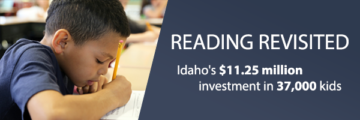In the McCall-Donnelly School District, Superintendent Jim Foudy said about 12 percent of his students have identified disabilities. Those range from challenges that a student is able to overcome — speech impediments, for example — to impairments that the student will work with for the rest of their lives.
 In Idaho, parents, teachers and administrators develop Individual Education Programs, or IEPs, that address a student’s specific needs. Some of Foudy’s students with IEPs take the IRI and other assessments, he said, while others take alternative assessments. That’s consistent with practices throughout the state.
In Idaho, parents, teachers and administrators develop Individual Education Programs, or IEPs, that address a student’s specific needs. Some of Foudy’s students with IEPs take the IRI and other assessments, he said, while others take alternative assessments. That’s consistent with practices throughout the state.
But students who don’t take the IRI don’t generate literacy money for their districts, regardless of their intervention needs.
“If a special education student took the IRI, then they would have been counted and funded. If a special education student took an alternate assessment, they were not funded,” said Jeff Church, communications specialist for the State Department of Education.
Another group of students is left out of the literacy initiative: Children who attend the Idaho School for the Deaf and the Blind in Gooding.
“Section 33-1002(s), Idaho Code, directs to distribute Literacy Intervention funds to school districts and public charter schools,” wrote Church in an e-mail to “Idaho Reports.” “The Idaho Bureau of Educational Services for the Deaf and the Blind (IBESDB) is neither a school district nor a public charter school.”
While special education students and students at the ISDB generate other funding sources for their districts, a new Office of Performance Evaluations report calls into question whether districts are receiving the full amount of funds for education services in the first place.
The OPE report, released Monday, points out that funding for special education is complex, but the issue boils down to this: Special education students are undercounted in Idaho’s public school districts and charter schools.
The report found that the special education funding formula set up in administrative rule counts four out of 10 special education students as regular students. So while those students are still generating money for their districts through their average daily attendance, that money isn’t set aside for special ed services and interventions like it would be if they were properly being counted.
Bob Thomas, who worked on the special education portion of the OPE report, said the takeaway shouldn’t be that special education is underfunded or overfunded. Rather, without accurate reporting mechanisms on the special education student population, there is no way to assess the funding.
“They have to know what the need is. They have to measure that first,” Thomas said. “That’s the missing link.”
Melissa Davlin is co-host of Idaho Public Television’s “Idaho Reports,” which collaborated on this week’s literacy series.
Literacy series, at a glance
Wednesday: Idaho schools try to bridge a wide reading gap
Wednesday: A close look at literacy dollars, and literacy demographics
Thursday: Literacy initiative tests political patience, and political will
Thursday: As Idaho revamps its literacy program, its reading test awaits a rewrite
Thursday: Rethinking literacy for special education students
Thursday: No clear picture on funding for special education
